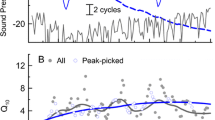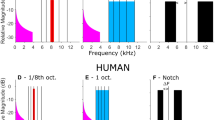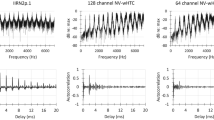Abstract
Otoacoustic emissions (sound emitted from the ear) allow cochlear function to be probed noninvasively. The emissions evoked by pure tones, known as stimulus-frequency emissions (SFOAEs), have been shown to provide reliable estimates of peripheral frequency tuning in a variety of mammalian and non-mammalian species. Here, we apply the same methodology to explore peripheral auditory function in the largest member of the cat family, the tiger (Panthera tigris). We measured SFOAEs in 9 unique ears of 5 anesthetized tigers. The tigers, housed at the Henry Doorly Zoo (Omaha, NE), were of both sexes and ranged in age from 3 to 10 years. SFOAE phase-gradient delays are significantly longer in tigers—by approximately a factor of two above 2 kHz and even more at lower frequencies—than in domestic cats (Felis catus), a species commonly used in auditory studies. Based on correlations between tuning and delay established in other species, our results imply that cochlear tuning in the tiger is significantly sharper than in domestic cat and appears comparable to that of humans. Furthermore, the SFOAE data indicate that tigers have a larger tonotopic mapping constant (mm/octave) than domestic cats. A larger mapping constant in tiger is consistent both with auditory brainstem response thresholds (that suggest a lower upper frequency limit of hearing for the tiger than domestic cat) and with measurements of basilar-membrane length (about 1.5 times longer in the tiger than domestic cat).






Similar content being viewed by others
Notes
We were unable to measure the lengths of the external ear canals in the tigers studied here. Using a 7-cm estimate obtained previously from one specimen, and assuming an upper bound of 25 % on the tiger-to-tiger variability, yields a corresponding uncertainty of less than 0.1 ms in the round-trip emission delay. At 10 kHz, this corresponds to an uncertainty of about 1 period in N SFOAE, or about 5 %. This 5 % uncertainty carries over to our estimate of Q ERB.
OAEs have been suggested to be of value in clinical veterinary contexts (e.g., McBrearty and Penderis 2011).
The ERB is a parameter-free measure of tuning bandwidth commonly adopted in the psychophysical literature. For any filter, the ERB is the bandwidth of the rectangular filter with the same peak response that passes the same total power when driven by white noise (Shera et al. 2010).
Several studies examining the mammalian tonotopic map have suggested that it can deviate from a simple exponential form at frequencies below about a few hundred Hz (Greenwood 1990), potentially facilitating sensitivity and selectivity across frequency (Lepage 2003; Vater and Kössl 2011). However, deviations from an exponential map appear not to occur in several small mammals such as guinea pig (Tsuji and Liberman 1997), mouse (Müller et al. 2005), and chinchilla (Müller et al. 2010). It is not known whether significant deviations from an exponential map are present in the tiger cochlea, or if tigers can be considered ‘auditory specialists’ (Vater and Kössl 2011) for other reasons (Walsh et al. 2011a). While a transition in cochlear processing between the base and apex (e.g., loss of scaling invariance) occurs in the mammalian cochlea (Shera and Guinan 2003; Temchin et al. 2008; Shera et al. 2010), the existence of the transition has not been shown to correlate with deviations from an exponential tonotopic map.
Abbreviations
- ABR:
-
Auditory brainstem response
- BM:
-
Basilar membrane
- DPOAE:
-
Distortion-product otoacoustic emission
- ERB:
-
Equivalent rectangular bandwidth
- OAE:
-
Otoacoustic emission
- SFOAE:
-
Stimulus-frequency otoacoustic emission
References
Backus BC, Guinan JJ (2007) Measurement of the distribution of medial olivocochlear acoustic reflex strengths across normal-hearing individuals via otoacoustic emissions. J Assoc Res Otolaryngol 8:484–496
Bergevin C (2011) Comparison of otoacoustic emissions within gecko subfamilies: morphological implications for auditory function in lizards. J Assoc Res Otolaryngol 12:203–217
Bergevin C, Shera CA (2010) Coherent reflection without traveling waves: on the origin of long-latency otoacoustic emissions in lizards. J Acoust Soc Am 127:2398–2409
Bergevin C, Freeman DM, Saunders JC, Shera CA (2008) Otoacoustic emissions in humans, birds, lizards, and frogs: evidence for multiple generation mechanisms. J Comp Physiol A 194:665–683
Bergevin C, Velenovsky D, Bonine KE (2010) Tectorial membrane morphological variation: effects upon stimulus frequency otoacoustic emissions. Biophys J 99(4):1064–1072
Francis NA, Guinan JJ (2010) Acoustic stimulation of human medial olivocochlear efferents reduces stimulus-frequency and click-evoked otoacoustic emission delays: implications for cochlear filter bandwidths. Hear Res 267:36–45
Greenwood DD (1990) A cochlear frequency-position function for several species—29 years later. J Acoust Soc Am 87:2592–2605
Guinan JJ (1990) Changes in stimulus frequency otoacoustic emissions produced by two-tone suppression and efferent stimulation in cats. In: Dallos P, Geisler CD, Matthews JW, Ruggero MA, Steele CR (eds) Mechanics and biophysics of hearing. Springer, New York, pp 170–177
Guinan JJ, Backus B, Lilaonitkul W, Aharonson V (2003) Medial olivocochlear efferent reflex in humans: otoacoustic emission (OAE) measurement issues and the advantages of stimulus frequency OAEs. J Assoc Res Otolaryngol 4:521–540
Huang GT, Rosowski JJ, Flandermeyer DT, Lynch TJ, Peake WT (1997) The middle ear of a lion: comparison of structure and function to domestic cat. J Acoust Soc Am 101:1532–1549
Huang GT, Rosowski JJ, Peake WT (2000) Relating middle-ear acoustic performance to body size in the cat family: measurements and models. J Comp Physiol A 186:447–465
Huang GT, Rosowski JJ, Ravicz ME, Peake WT (2002) Mammalian ear specializations in arid habitats: structural and functional evidence from sand cat Felis margarita. J Comp Physiol A 188:663–681
Joris PX, Bergevin C, Kalluri R, McLaughlin M, Michelet P, van der Heijden M, Shera CA (2011) Frequency selectivity in Old-World monkeys corroborates sharp cochlear tuning in humans. Proc Nat Acad Sci USA 108:17516–17520
Kalluri R, Shera CA (2007) Comparing stimulus-frequency otoacoustic emissions measured by compression, suppression, and spectral smoothing. J Acoust Soc Am 122:3562–3575
Kemp DT (1986) Otoacoustic emissions, travelling waves and cochlear mechanisms. Hear Res 22:95–104
Knight RD, Kemp DT (2000) Indications of different distortion product otoacoustic emission mechanisms from a detailed f 1,f 2 area study. J Acoust Soc Am 107:457–473
Köppl C (1995) Otoacoustic emissions as an indicator for active cochlear mechanics: a primitive property of vertebrate auditory organs. In: Manley GA, Klump GM, Köppl K, Fastl H, Oeckinghaus H (eds) Advances in hearing research, World Scientific, Singapore, pp 207–218
Kössl M, Moeckel D, Weber M, Seyfarth EA (2008) Otoacoustic emissions from insect ears: evidence of active hearing? J Comp Physiol A 194:597–609
Lepage EL (2003) The mammalian cochlear map is optimally warped. J Acoust Soc Am 114:896–906
Liberman MC (1982) The cochlear frequency map for the cat: labeling auditory-nerve fibers of known characteristic frequency. J Acoust Soc Am 72:1441–1449
McBrearty AR, Penderis J (2011) Evaluation of auditory function in a population of clinically healthy cats using evoked otoacoustic emissions. J Feline Med Surg 13:919–926
Meenderink SW, Narins PM (2006) Stimulus frequency otoacoustic emissions in the Northern leopard frog, Rana pipiens pipiens: implications for inner ear mechanics. Hear Res 220:67–75
Müller M, von Hünerbein K, Hoidis S, Smolders JW (2005) A physiological place-frequency map of the cochlea in the CBA/J mouse. Hear Res 202:63–73
Müller M, Hoidis S, Smolders JW (2010) A physiological frequency-position map of the chinchilla cochlea. Hear Res 268:184–193
Probst R, Lonsbury-Martin BL, Martin GK (1991) A review of otoacoustic emissions. J Acoust Soc Am 89:2027–2067
Ravicz ME, Olson ES, Rosowski JJ (2007) Sound pressure distribution and power flow within the gerbil ear canal from 100 Hz to 80 kHz. J Acoust Soc Am 122:2154–2173
Shera CA, Guinan JJ (1999) Evoked otoacoustic emissions arise by two fundamentally different mechanisms: a taxonomy for mammalian OAEs. J Acoust Soc Am 105:782–798
Shera CA, Guinan JJ (2003) Stimulus-frequency-emission group delay: a test of coherent reflection filtering and a window on cochlear tuning. J Acoust Soc Am 113:2762–2772
Shera CA, Guinan JJ, Oxenham AJ (2002) Revised estimates of human cochlear tuning from otoacoustic and behavioral measurements. Proc Nat Acad Sci USA 99:3318–3323
Shera CA, Guinan JJ, Oxenham AJ (2010) Otoacoustic estimation of cochlear tuning: validation in the chinchilla. J Assoc Res Otolaryngol 11:343–365
Siegel JH (1994) Ear-canal standing waves and high-frequency sound calibration using otoacoustic emission probes. J Acoust Soc Am 95:2589–2597
Sisto R, Moleti A, Shera CA (2007) Cochlear reflectivity in transmission-line models and otoacoustic emission characteristic time delays. J Acoust Soc Am 122:3554–3561
Temchin AN, Rich NC, Ruggero MA (2008) Threshold tuning curves of chinchilla auditory-nerve fibers. I. Dependence on characteristic frequency and relation to the magnitudes of cochlear vibrations. J Neurophysiol 100:2889–2898
Titze IR, Fitch WT, Hunter EJ, Alipour F, Montequin D, Armstrong DL, McGee J, Walsh EJ (2010) Vocal power and pressure-flow relationships in excised tiger larynges. J Exp Biol 213:3866–3873
Tsuji J, Liberman MC (1997) Intracellular labeling of auditory nerve fibers in guinea pig: central and peripheral projections. J Comp Neurol 381:188–202
Úlehlová L, Burda H, Voldich L (1984) Involution of the auditory neuro-epithelium in a tiger (Panthera tigris) and a jaguar (Panthera onca). J Comp Pathol 94:153–157
Vater M, Kössl M (2011) Comparative aspects of cochlear functional organization in mammals. Hear Res 273:89–99
Walsh EJ, Ketten DR, Arruda J, Armstrong DL, Curro T, Simmons LG, Wang LM, McGee J (2004) Temporal bone anatomy in Panthera tigris. J Acoust Soc Am 115:2485–2486
Walsh EJ, Armstrong DL, Napier J, Simmons LG, Korte M, McGee J (2008) Acoustic communication in Panthera tigris: a study of tiger vocalization and auditory receptivity revisited. J Acoust Soc Am 123:3507
Walsh EJ, Armstrong DL, McGee J (2011a) Comparative cat studies: are tigers auditory specialists? J Acoust Soc Am 129:2447
Walsh EJ, Armstrong DL, McGee J (2011b) Tiger bioacoustics: an overview of vocalization acoustics and hearing in Panthera tigris. In: 3rd symposium on acoustic communication by animals, Cornell University, Ithaca, NY, pp 173–174
West CD (1985) The relationship of the spiral turns of the cochlea and the length of the basilar membrane to the range of audible frequencies in ground dwelling mammals. J Acoust Soc Am 77:1091–1101
Acknowledgments
The support, advice, and assistance of the veterinarians and staff of the Henry Doorly Zoo were invaluable to the completion of this study. All procedures were approved by the Institutional Animal Care and Use Committee. We thank Sebastiaan Meenderink and John Rosowski for helpful comments on the manuscript. The work was supported by the National Science Foundation (grants 0823417 and 0602173), the Howard Hughes Medical Institute (grant 52003749), and the National Institutes of Health (grants R01 DC003687 and P30 DC05209).
Author information
Authors and Affiliations
Corresponding author
Rights and permissions
About this article
Cite this article
Bergevin, C., Walsh, E.J., McGee, J. et al. Probing cochlear tuning and tonotopy in the tiger using otoacoustic emissions. J Comp Physiol A 198, 617–624 (2012). https://doi.org/10.1007/s00359-012-0734-1
Received:
Revised:
Accepted:
Published:
Issue Date:
DOI: https://doi.org/10.1007/s00359-012-0734-1




